Studies on variability, heritability and genetic advance for yield attributing traits in Brinjal (Solanum melongena L.) for two different seasons
Bạn đang xem bản rút gọn của tài liệu. Xem và tải ngay bản đầy đủ của tài liệu tại đây (252.39 KB, 10 trang )
Int.J.Curr.Microbiol.App.Sci (2018) 7(9): 1543-1552
International Journal of Current Microbiology and Applied Sciences
ISSN: 2319-7706 Volume 7 Number 09 (2018)
Journal homepage:
Original Research Article
/>
Studies on Variability, Heritability and Genetic Advance for
Yield Attributing Traits in Brinjal (Solanum melongena L.)
for Two Different Seasons
Priyanka Verma*, M.L. Kushwaha and Ankit Panchbhaiya
Department of Vegetable Science, Govind Ballabh Pant University of Agriculture and
Technology, Pantnagar (Uttarakhand), India
*Corresponding author
ABSTRACT
Keywords
Brinjal, Genetic
variability, Heritability,
GCV, Genetic advance as
a percent of mean and
PCV
Article Info
Accepted:
10 August 2018
Available Online:
10 September 2018
The present experiment was laid down in randomized block design in two different
environments (E1 and E2) with the objective to assess the magnitude of genetic variability,
heritability and genetic advance among 18 yield attributing traits in brinjal. The analysis of
variance revealed that significant genetic differences were present among the brinjal
genotypes representing the existence of significant amount of variability widening the
greater scope for the improvement of concerned characters through selection. A moderate
to wide range of mean values among the genotypes for different characters were observed.
Moderate to high genotypic coefficient of variation together with moderate to high
heritability and genetic advance as per cent of mean was reported for majority of the
characters under study except days to 50 percent flowering, number of primary branches,
fruit diameter and days to first fruiting in E2 season which indicated predominant role of
additive genetic component in the expression of these traits arising a chance of genetic
improvement through phenotypic selection.
Introduction
Brinjal (Solanum melongena L.) is one of the
most important and popular solanaceous
vegetable crops of India. Easy cultivation,
year round availability, moderate to high yield
and consumption in varieties of ways like as a
vegetable, salad, bhaji, bhartha, chatni, pickles
etc., has made brinjal the king of vegetables in
India. The ethno-botanical history of brinjal
has been quite fascinating which has indicated
that it has been used for vegetable, medicinal
and ornamental purposes since ancient time in
India. The 21st century begins new vistas
regarding the health value of brinjal, which is
mainly due to its phenolics, glycoalkaloids,
amide and anthocyanine content generally
present in the peel of brinjal fruits. It is a rich
source of vitamin A, B1, B6 and trace amount
of micro nutrient like Cu, Mn, Mg, K (Chen
and Li, 1996) and its fruits are mainly used to
cure diabetes (Choudhary, 1976), toothache
(Chen and Li, 1996), liver complaints and
possess antioxidant and anti-cancer activities
due to the presence of anthocyanin and
polyphenol compound (Sato et al., 2011).
1543
Int.J.Curr.Microbiol.App.Sci (2018) 7(9): 1543-1552
Brinjal can be grown in wide range of agroclimatic zones round the year which provides
us a great opportunity to exploit its full
potential on condition of its tremendous scope
of crop improvement. Planning and
implementing of any breeding programme for
the improvement of the various quantitative
attributes of crop depend upon the extent and
magnitude of genetic variability offered in the
population. Variation is the secret of success
in plant breeding program because it widens
the scope of selection. The genetic facts are
inferred from observations on phenotypes.
Since phenotype is an artifact of the joint
effects of genotype and environment, nongenetic part exerts large influence on genetic
variability.
The exploitable variability is, therefore
required to be judged through various genetic
parameters like coefficient of variation at
phenotypic and genotypic level, heritability
and genetic advance. The estimates of
heritability serves as a useful guide for the
breeder as it enable them to understand the
proportion of variation is due to genotypic
effect or additive effect and provide the
correct indication of the amount of
improvement achieved through selection
whereas, high heritability along with high
genetic advance as a percent of mean is an
indication of more additive gene action
(Panse, 1957). Most of the local varieties
which are grown by the farmers of India have
not been fully utilized in any genetic
improvement programs so far, on scientific
line. Hence, the present study was under taken
with an objective of studying the variability,
heritability and genetic advance in different
genotypes of brinjal, which can be utilized in
future crop improvement programmes.
Materials and Methods
By taking 36 genotypes of brinjal, the present
investigation was carried out at Vegetable
research centre of G. B. Pant University of
agriculture and technology during autumn –
winter (E1) and spring – summer (E2) season
of 2017-18. The experiment was laid out in
Randomized block design in which genotypes
were arranged in three replication, each
replication containing 36 treatments. The
genotypes were studied for 18 yield attributing
traits viz., days to first flowering, days to 50
percent flowering, days to first fruiting,
number of primary branches, plant height
(cm), fruit length (cm), fruit diameter (cm),
fruit index, average fruit weight (g), number
of healthy fruits per plant, number of infested
fruits per plant, total number of fruits per
plant, percent of shoot and fruit borer
incidence, weight of healthy fruits per plant,
weight of infested fruits per plant, total yield
per plant (kg), fruit yield per hectare (q/hac)
and 100 seed weight (g) in both E1 and E2
seasons The analysis of variance was carried
out as per methods suggested by Panse and
Sukhatme (1967).
Methods given by Burton and De Vane (1953)
were used to determine the genotypic
coefficient of variation (GCV) and phenotypic
coefficient of variation (PCV). Whereas,
heritability (broad sense) and genetic advance
as per cent of mean was computed as per
Weber and Moorthy (1952) and Johnson et al.,
(1955), respectively.
Results and Discussion
The analysis of variance signifies that the
mean sum of square due to treatment was
found highly significant for all the yield
attributing traits studied in both the E1 and E2
seasons at 1% and 5% level of significance.
The significant difference among all the traits
indicates the existence of sufficient amount of
genetic variability, offering the good
opportunity for the improvement of various
economic traits in brinjal as presented in Table
1 and 2. The results are in consonance with
1544
Int.J.Curr.Microbiol.App.Sci (2018) 7(9): 1543-1552
Chourasia and Shree (2012), Shekar et al.,
(2012), Nayak and Nagre (2013), Madavi et
al., (2015), Mohammad et al., (2015), Vidya
and Kumar (2015), Reshmika et al., (2015),
Pujer et al., (2017), Ravali et al., (2017),
Tripathy et al., (2017) and Tirkey et al.,
(2018).
Variability refers to the presence of
differences among the individuals of a
population which is essential for wider
adaptability and resistance to biotic and a
biotic factors and hence, an insight into the
magnitude of genetic variability present in a
population is of paramount important to a
plant breeder for starting a judicious breeding
programme.
The extent of genetic variation can be judged
by both the estimation of phenotypic
coefficient of variation (PCV) and genotypic
coefficient of variation (GCV). The estimates
of phenotypic coefficient of variation (PCV),
genotypic coefficient of variation (GCV),
heritability in broad sense and genetic advance
as a percent of mean for eighteen yield
attributing traits in E1 and E2 season are
presented in Table 3 and 4.
Assessment of variability parameters revealed
that there is lot of variation present among the
genotypes studied. In general, the value of
phenotypic coefficient of variation (PCV) was
higher than the genotypic coefficient of
variation (GCV) for all the characters studied
in the present study, indicating the
considerable influence of environmental
factors on the performance of genotypes for
different characters. Similar results were also
reported in brinjal by Nayak and Nagre
(2013), Patel et al., (2015) and Tripathy et al.,
(2017).
Among 36 genotypes of brinjal, highest GCV
and PCV estimate were received for most of
the traits viz., fruit index (69.087 and 71.989),
weight of infested fruits per plant (48.738 and
51.07), number of healthy fruits per plant
(45.12 and 48.46), number of infested fruits
per plant (41.68 and 46.61), weight of healthy
fruits per plant (41.583 and 42.661), fruit
length (37.99 and 39.19), percent of shoot and
fruits borer incidence (39.630 and 42.751),
total number of fruits per plant (38.28 and
40.03), fruit yield per hectare (33.97 and
37.970), total yield per plant (32.481 and
36.578), fruit diameter (27.55 and 31.46), 100
seed weight (24.935 and 26.193) and average
fruit weight (23.34 and 23.50) in E1 season.
Whereas in E2 season, high GCV and PCV
estimates were observed for fruit index
(56.078 ad 56.078), number of healthy fruits
per plant(47.961 and 48.75), number of
infested fruits per plant (46.961 and 48.036),
total number of fruits per plant (44.993 and
46.824), average fruit weight (38.436 and
38.81), fruit length (37.96 and 39.512),
percent of shoot and fruit borer incidence
(31.614 and 34.912), fruit diameter (30.772
and 35.688), weight of healthy fruits per plant
(29.217 and 30.380), weight of infested fruits
per plant (29.292 and 29.651), 100 seed
weight (25.779 and 26992), fruit yield per
hectare (24.35 and 25.61), total yield per plant
(24.302 and 25.704) and number of primary
branches (22.781 and 26.350). The higher
values of PCV and GCV for the above traits
signifies there maximum contribution towards
genetic variability and thereby suggesting that
the parents chosen on the basis of these
characters may be utilized in further crossing
programme for obtaining good transgressive
segregants. The results of the present
investigation agreed with the finding of Ansari
et al., (2011), Shekar et al., (2012), Balaji et
al., (2013), Singh et al., (2013a), Kumar et al.,
(2013b), Chaudhary and Kumar (2014), Mili
et al., (2014), Gavade and Ghadage (2015),
Madhavi et al., (2015), Patel et al., (2015),
Shende et al., (2014),Vidya and Kumar
(2015), Ravali et al., (2017), Sujin et al.,
(2017).
1545
Int.J.Curr.Microbiol.App.Sci (2018) 7(9): 1543-1552
Table.1 Analysis of variance for different yield attributing traits in brinjal for E1 season
S. N.
Characters
Mean sum of squares
Replication
Genotype
Error
df
2
35
70
Days to first flowering
1.878
69.355**
1.356
1
Days to 50 percent flowering
2.083
91.581**
1.901
2
Days
to
first
fruiting
0.562
91.996**
2.901
3
No. of Primary branches
0.745
13.420**
1.35
4
Plant height (cm)
128.823
513.424**
28.371
5
Fruit length (cm)
1.617
89.982**
1.876
6
Fruit diameter (cm
0.166
7.133**
0.655
7
Fruit index
0.122
14.496**
0.403
8
Average fruit weight (g)
3.865
1021.634**
4.794
9
No. of healthy fruits per plant
15.176
98.013**
4.907
10
No. of infested fruit per plant
0.121
17.040**
1.314
11
Total
no.
of
fruit
per
plant
14.858
144.376**
4.358
12
Percent of shoot and fruit borer incidence
5.022
535.277**
27.692
13
Weight of healthy fruits per plant (Kg)
0.005
0.452**
0.008
14
Weight of infested fruits per plant (Kg)
0.007
0.119**
0.004
15
Total yield per plant (Kg)
0.068
0.590**
0.048
16
Fruit yield per hectare (q/hac)
3577.333
28410.440**
2366.694
17
100 seed weight (g)
0.003
0.022**
0.001
18
* Significant at 5% level of probability ** Significant at 1% level of probability
Table.2 Analysis of variance for different yield attributing traits in brinjal for E2 season
S. N.
Characters
Mean sum of squares
Replication
Genotype
Error
df
2
35
70
13.406
178.868**
10.566
1 Days to first flowering
63.696
130.111**
18.257
2 Days to 50 percent flowering
100.738
88.827**
36.712
3 Days to first fruiting
3.017
8.909**
0.902
4 No. of Primary branches
7.961
409.453**
7.971
5 Plant height (cm)
2.184
81.139**
1.919
6 Fruit length (cm)
0.202
6.328**
0.653
7 Fruit diameter (cm
0.371
12.990**
0.699
8 Fruit index
12.043
2310.978** 15.047
9 Average fruit weight (g)
0.658
55.363**
0.637
10 No. of healthy fruits per plant
5.792
77.915**
1.184
11 No. of infested fruit per plant
41.296
231.045**
6.224
12 Total no. of fruit per plant
16.727
1036.893** 94.395
13 Percent of shoot and fruit borer incidence
0.002
0.073**
0.002
14 Weight of healthy fruits per plant (Kg)
0.022
0.122**
0.001
15 Weight of infested fruits per plant (Kg)
0.038
0.266**
0.01
16 Total yield per plant (Kg)
1883.139
13115.400** 499.49
17 Fruit yield per hectare (q/hac)
0.003
0.024**
0.001
18 100 seed weight (g)
* Significant at 5% level of probability ** Significant at 1% level of probability
1546
Int.J.Curr.Microbiol.App.Sci (2018) 7(9): 1543-1552
Table.3 Estimation of coefficient of variation and other genetic parameter in brinjal for
E1 season
Sl.
No.
Characters
General
mean
Range
1
44.13
5
Days
to
first
flowering
Days to 50 percent
flowering
Days
to
first
fruiting
No. of Primary
branches
Plant height (cm)
136.92
6
Fruit length (cm)
14.26
7
Fruit
diameter
(cm
Fruit index
5.33
Average
fruit
weight (g)
No. of healthy
fruits per plant
No. of infested
fruit per plant
Total no. of fruit
per plant
Percent of shoot
and fruit borer
incidence
Weight of healthy
fruits per plant
(Kg)
Weight of infested
fruits per plant
Kg)
Total yield per
plant (Kg)
Fruit yield per
hectare (q/hac)
100 seed weight (g)
78.89
35.2652.2
40.09661.46
43.23365.433
6.7514.486
101.546164.993
5.43434.24
2.9339.476
0.952 11.67
48.952 130.597
3.15328.556
2.09911.483
7.42439.836
15.50578.453
2
3
4
8
9
10
11
12
13
14
15
16
17
18
50.84
56.05
10.19
3.09
12.35
5.49
17.85
32.09
Coefficient of variation
Heritability G.A. as
(%)
%
GCV% PCV% ECV%
mean
10.79
11.11
2.64
94.35
21.589
10.75
11.09
2.71
94.02
21.481
9.72
10.19
3.04
91.11
19.118
19.69
22.75
11.4
74.88
35.091
9.29
10.07
3.89
85.06
17.559
37.99
39.19
9.6
93.99
75.875
27.55
31.46
15.18
76.72
49.715
69.087
71.989
20.53
92.1
136.63
23.34
23.5
2.78
98.6
47.735
45.12
48.46
17.94
86.35
86.199
41.68
46.61
20.87
79.96
76.778
38.28
40.03
11.7
91.46
75.422
39.63
42.751
25.17
85.935
75.68
0.91
0.2331.876
41.583
42.661
22.22
95.009
83.496
0.39
0.1410.992
48.738
51.07
21.24
90.977
95.763
1.31
0.6522.437
144.960541.663
0.170.58
32.481
36.578
16.91
78.854
59.417
33.97
37.97
16.95
80.06
61.123
24.935
26.193
9.27
90.629
48.901
288.38
0.34
1547
Int.J.Curr.Microbiol.App.Sci (2018) 7(9): 1543-1552
Sl.
No.
1
2
3
4
5
6
7
8
9
10
11
12
13
14
15
16
17
18
Table.4 Estimation of coefficient of variation and other genetic parameter in brinjal for
E2 season
Characters
General
Range
Coefficient of variation Herita G.A. as
mean
%
GCV
PCV
ECV bility
(%)
mean
%
%
%
58.8
43 - 75.436
12.73 13.887 5.53
84.15 24.073
Days to first flowering
98.2- 129.666
5.181
6.323
4.53
67.13
8.744
Days to 50 percent 117.44
flowering
130.38
108.4 - 140.6
3.19
5.641
4.65
32.12
3.732
Days to first fruiting
7.17
3.873 - 11.546 22.781 26.35 13.24 74.741 40.571
No.
of
Primary
branches
64.03
46.243 - 92.843 18.066 18.596 4.41 94.379 36.155
Plant height (cm)
13.54
5.087-29.74
37.96 39.312 10.23 93.224 75.496
Fruit length (cm)
4.47
2.044 - 8.076
30.772 35.688 18.08 74.345 54.657
Fruit diameter (cm
3.52
0.808 - 8.620
56.078 60.673 23.74 85.427 106.772
Fruit index
71.97
21.14 - 133.273 38.436 38.81
5.39 98.072 78.411
Average fruit weight (g)
8.91
2.576 - 26.28
47.961 48.75
8.96 96.627 97.067
No. of healthy fruits per
plant
3.576 - 26.778 46.961 48.036 10.11 95.574 94.575
No. of infested fruit per 10.77
plant
7.424 - 53.058 44.993 46.824 12.97 92.332 89.062
Total no. of fruit per 19.24
plant
35.547 31.614 34.912 16.99 76.896 55.302
Percent of shoot and 57.18
146.489
fruit borer incidence
0.53
0.188 - 0.852
29.217 30.38
8.32 92.489 57.883
Weight of healthy fruits
per plant (Kg)
0.68
0.278 - 1.172
29.292 29.651 4.59 97.597 59.612
Weight of infested fruits
per plant Kg)
1.2
0.581 - 1.782
24.302 25.704 8.37 89.383 47.329
Total yield per plant
(Kg)
129.183 24.35
25.61
7.94
90.38
47.69
Fruit yield per hectare 266.84
396.144
(q/hac)
0.34
0.138 - 0.57
25.779 26.992 7.99 91.218 50.72
100 seed weight (g)
With the help of PCV and GCV alone it is not
possible to determine the amount of variation
which is heritable. The combination of high
heritability along with high genetic advance
will provide a clear base on the reliability of
that particular trait in the selection of variable
entries. In the present study broad sense
heritability was found high for all the
characters except for number of primary
branches in both the season while for fruit
diameter, days to 50% flowering and days to
first fruiting in E2 season. In E1 season, the
maximum estimates of heritability were
recorded for average fruit weight (98.60)
followed by weight of healthy fruits per plant
(95.009), days to first flowering (94.35), days
to 50% flowering (94.02), fruit length (93.99),
fruit index (92.100), total number of fruits per
1548
Int.J.Curr.Microbiol.App.Sci (2018) 7(9): 1543-1552
plant (91.46), days to first fruiting
(91.11),weight of infested fruits per plant
(90.977), 100 seed weight (90.629), number
of healthy fruits per plant (86.35), percent of
shoot and fruit borer incidence (85.935), plant
height (85.06), fruit yield per hectare (80.06),
number of infested fruits per plant (79.96),
total yield per plant (78.854) and fruit
diameter (76.72). Whereas, in E2 season the
maximum estimate of heritability was
recorded for average fruit weight (98.072)
followed by weight of infested fruits per plant
(97.597), number of healthy fruits per plant
(96.627), number of infested fruits per plant
(95.574), plant height (94.379), fruit length
(93.224), weight of healthy fruits per plant
(92.489), total number of fruits per plant
(92.332), 100 seed weight (91.218), fruit yield
per hectare (90.38), total fruit yield per plant
(89.383), fruit index (85.427), days to first
flowering (84.15) and percent of shoot and
fruit borer incidence (76.896). The high
heritability estimates for these traits indicate
that these characters are least influenced by
the environment.
The genetic advance in a trait is an artifact of
the heritability and selection differential
expressed in terms of phenotypic standard
deviation of the trait concerned and for
comparison it is better to express the
characters in terms of genetic advance as a
percentage of mean. In the present study
higher estimates of genetic advance as
percentage of mean (> 20%) was observed for
most of the characters under study in E1
season starting from fruit index (136.63)
followed by weight of infested fruits per plant
(95.763), number of healthy fruits per plant
(86.199), weight of healthy fruits per plant
(83.496), number of infested fruits per plant
(76.778), fruit length (75.875), percent of
shoot and fruit borer incidence (75.680), total
number of fruits per plant (75.422), fruits
yield per hectare (61.123), total fruits per
plant (59.417), fruit diameter (49.715) 100
seed weight (48.901), average fruit weight
(47.735), number of primary branches
(35.091) days to first flowering (21.589), and
days to 50 % flowering (21.481). While for
E2 season, fruit index (106.772) followed by
number of healthy fruits per plant (97.067),
number of infested fruits per plant (94.575),
total number of fruits per plant (89.062),
average fruit weight (78.411), fruit length
(75.496), weight of infested fruits per plant
(59.612), weight of healthy fruits per plant
(57.883), percent of shoot and fruit borer
incidence (55.302), fruit diameter (54.657),
100 seed weight (50.720), fruit yield per
hectare (47.69), total yield per plant (47.329),
number of primary branches (40.571), plant
height (436.155) and days to first flowering
(24.073) recorded the maximum estimates of
genetic advance as percent of mean. High
estimates of genetic advance as percentage of
mean indicated that the preponderance of
additive genetic effects in expression of these
characters. Therefore, selection for these
characters in segregating generations based on
phenotypic performance would likely be more
effective.
All the characters studied showed high to
high, moderate to high or high to moderate
values of heritability along with high genetic
advance as a percent of mean except for days
to 50 percent of flowering, number of primary
branches, fruit diameter and days to first
fruiting in E2 season showing low to low or
moderate to low values of heritability along
with low genetic advance. High heritability
along with high genetic advance among the
resulted traits indicate the predominant role of
additive genetic component in expression of
the traits hence, phenotypic selection will be
rewarding for the further improvement of
such traits. For different characters, similar
results were also observed by various
researchers like Chattopadhyay et al., (2011),
Indiresh and Santhosha (2011), Thangavel et
al., (2011), Dhaka and Soni (2012), Kumar et
1549
Int.J.Curr.Microbiol.App.Sci (2018) 7(9): 1543-1552
al., (2013a), Chaudhary and Kumar (2014),
Mili et al., (2014), Gavade and Ghadage
(2015), Patel et al., (2015), Tripathy et al.,
(2017) and Tirkey et al., (2018).
The present investigation on brinjal revealed
the presence of substantial amount of
exploitable variability in the material studied
with respect to 18 yield attributing traits
projecting, thereby, immense scope for
genetic improvement through selection and
hybridization. The study further elucidated
that both non-additive and additive genetic
component played the vital role in governing
the expression of yield and its major
components. Moderate to high GCV together
with moderate to high heritability and genetic
advance as per cent of mean was reported for
majority of the characters under study which
indicated predominant role of additive genetic
component in the expression of these traits
arising a chance of genetic improvement
through phenotypic selection.
References
Ansari, S. F., Mehta, N., Ansari S. and Gavel,
J. P. 2011. Variability studies in Brinjal
(Solanum
melongena
L.)
in
Chhattisgarh plains. Electronic Journal
of Plant Breeding, 2(2): 275-281.
Balaji, L., Reddy, P. S., Reddy, R. V. S. K.
and Sivaraj, N. 2013. Variability,
heritability and genetic advance studies
in Brinjal (Solanum melongena L.).
Electronic Journal of Plant Breeding,
4(1): 1097-1100.
Burton, G. W. and Devane, E. W. 1953.
Estimating heritability in fall fescue
(Festuca arundinacea) form replicated
clonal material. Agronomy Journal, (4):
78-81.
Chattopadhyay, A., Dutta, S. and Hazra, P.
2011. Characterization of genetic
resources and identification of selection
indices of brinjal (Solanum melongena
L.) grown in Eastern India. Vegetable
Crops Research Bulletin, 74: 39-49.
Chaudhary, P. and Kumar, S. 2014.
Variability, heritability and genetic
advance studies in eggplant (Solanum
melongena L.). Plant Archives, 14(1):
483-486.
Chen, N. C. and Li, H. M. 1996. Cultivation
and Seed Production of Eggplant.
AVRDC, Annual Publication, 203(64):
246-261.
Choudhary B. 1976. Vegetables (4th ed.).
National Boot Trust, New Delhi. Pp.
50-58.
Chourasia, H. K. and Shree, S. 2012. Genetic
variability in quantitative characters of
brinjal (Solanum melongena L.).
Journal of Interacademicia, 16(2): 196202.
Dhaka, S. K. and Soni, A. K. 2012. Genetic
variability
in
brinjal
(Solanum
melongena L.). The Asian Journal of
Horticulture, 7(2): 537-540.
Gavade, R. T. and Ghadage, B. A. 2015.
Genetic variability, heritability and
genetic
advance
in
segregating
generation
of
Brinjal
(Solanum
melongena L.). Bioinfolet, 12(1C): 325328.
Indiresh, K. K. M. and Santhosha, H. M.
2011. Genetic variability in brinjal
(Solanum melongena L.). Environment
and Ecology, 29(3B): 1686-1688.
Johnson, H. W., Robinson, H. F. and
Comstock. 1955. Estimates of genetic
and environmental variability in
soybean. J. Agric., 45: 478-481.
Kumar, S. R., Arumugam, T., Anandakumar,
C. R., and Premalakshmi, V. 2013.
Genetic variability for quantitative and
qualitative
characters
in
brinjal
(Solanum melongena L.). African
Journal of Agricultural Resources,
8(39): 4956-4959.
Madhavi, N., Mishra, A. C., Om Prasad, J.,
and Bahuguna, N. 2015. Studies on
1550
Int.J.Curr.Microbiol.App.Sci (2018) 7(9): 1543-1552
variability, heritability and genetic
advance in brinjal (Solanum melongena
L.). Plant Archives, 15(1): 277-281.
Mili, C., Bora, G. C., Das, B., and Paul, S. K.
2014. Studies on variability, heritability
and genetic advance in brinjal (Solanum
melongena
L.)
genotypes. Direct
Research Journal of Agricultural and
Food Science, 2(11): 192-194.
Mohammad, R. N. R., Mahdiyeh, P.,
Abdolrahim, G. and Javad, A.
2015.Variability,
heritability
and
association analysis in eggplant
(Solanum melongena). Journal of
Agricultural and Biological Science,
10(12): 464 -468.
Nayak, B. R. and Nagre, P.K. 2013. Genetic
variability and correlation studies in
brinjal (Solanum melongena L.).
Internat. J. Appl. Biol. & Pharmaceut.
Technol., 4(4): 211-215.
Panse, V. G. 1957. Genetics of quantitative
characters in relation to plant breeding.
Indian J. Genet., 17: 318-328.
Panse, V. G. and Shukhatme, P. V. 1967.
Statistical Methods for Agricultural
Workers. 2nd ed. ICAR Publications
Krishi Anusandhan Bhavan, Pusa, New
Delhi-11001.
Patel, K., Patel, N. B., Patel, A. I., Rathod, H.,
and Patel, D. 2015. Study of variability,
correlation and path analysis in brinjal
(Solanum
melongena
L.). The
bioscan, 10(4): 2037-2042.
Pujer, P., Jagadeesha, R. C., and Cholin, S.
2017. Genetic variability, heritability
and genetic advance for yield, yield
related components of brinjal (Solanum
melongena L.) genotypes. Int. J. Pure
App. Biosci., 5(5): 872-878.
Ravali, B. K., Reddy, R., Saidaiah, P. and
Shivraj,
N.
2017.
Variability,
Heritability and Genetic advance in
brinjal (Solanum melongena L.).
International Journal of Current
Microbiology and Applied Sciences,
6(6): 42-47.
Reshmika, P. K., Gasti, V. D., Evoor, S.,
Jayappa, J. and Mulge, R. 2015. Genetic
variability studies for growth, earliness,
yield and quality parameters in brinjal
(Solanum melongena L.). Environment
& Ecology, 33 (2): 761-766.
Sato, Y., Itagaki, S., Kurokawa, T., Ogura, J.,
Kobayashi, M., Hirano, T., Sugawara,
M. and Iseki, K. 2011. In vitro and in
vivo
antioxidant
properties
of
chlorogenic acid and caffeic acid.
International Journal of Pharmaceutics,
403:136-138.
Shekar, K. C., Ashok. P. and Sasikala, K.
2012. Studies on heritability and
multivariate
analyses
in
brinjal
(Solanum melongena L.) Vegetable
crops resource Bulletin, 76: 79-88.
Shende, K. G., Birajdar, U. M., Bhalekar, M.
N. and Patil, B. T. 2014. Correlation
and path analysis in eggplant (Solanum
melongena
L.).
South
Indian
Horticulture Journal, 39(1): 108-110.
Singh, O., Singh, B., Singh, K. V., Chand, P.
and Vaishali. 2013. Studies on genetic
variability
in
brinjal
(Solanum
Melongena L.). Annals of Horticulture,
6(2): 279-283.
Sujin, G. S., Karuppaiah, P. and Saravanan,
K. 2017. Genetic variability and
correlation studies in brinjal (Solanum
melongena L.). Indian Journal of
Agricultural Resource, 51(2): 112-119.
Thangavel, P., Thirugnanakumar, S. and
Baradhan, G. 2011. Studies on genetic
variability, heritability and genetic
advance in segregating generations of
brinjal (Solanum melongena L.). Plant
Archives, 11(1): 453-456.
Tirkey, M., Saravana, S and Pushpa lata.
2018. Studies on variability, heritability
and genetic advance for yield and its
attributes
in
brinjal
(Solanum
melongena
L.).
Journal
of
1551
Int.J.Curr.Microbiol.App.Sci (2018) 7(9): 1543-1552
Pharmacognosy and Phytochemistry,
1181-1183
Tripathy, B., Dhananjay, S., Jangde, B. P. and
Bairwa, P. L. 2017. Genetic variability
and heritability studies in brinjal
(Solanum melongena L.). Journal of
Pharmacognosy and Phytochemistry,
10: 109-116.
Vidhya, C. and Kumar, N. 2015. Genetic
variability studies in Brinjal (Solanum
melongena) for fruit yield and quality.
Electronic Journal of Plant Breeding,
6(3): 668-671
Vidhya, C. and Kumar, N. 2015. Genetic
variability studies in Brinjal (Solanum
melongena) for fruit yield and quality.
Electronic Journal of Plant Breeding,
6(3): 668-671
Weber, C. R. and Moorthy, H. R. 1952.
Heritable and non- heritable relationship
and variability of oil content and
agronomic characters in the F2
generation of soyabean crosses.
Agronomy Journal, 44: 202-209.
How to cite this article:
Priyanka Verma, M.L. Kushwaha and Ankit Panchbhaiya. 2018. Studies on Variability,
Heritability and Genetic Advance for Yield Attributing Traits in Brinjal (Solanum melongena
L.) for Two Different Seasons. Int.J.Curr.Microbiol.App.Sci. 7(09): 1543-1552.
doi: />
1552
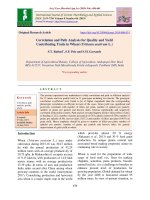
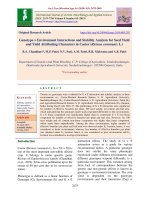
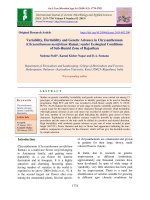

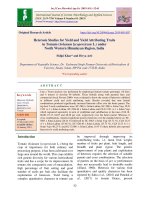
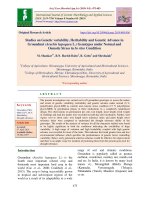

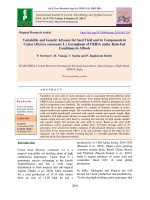
![Studies on genetic variability, heritability and genetic advance in F2 segregating population of Cross Arka Archana × AAC-1 in China Aster [Callistephus chinensis (L.) Nees]](https://media.store123doc.com/images/document/2020_01/14/medium_pyb1578991636.jpg)
